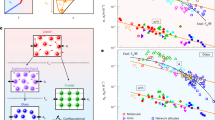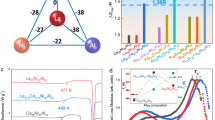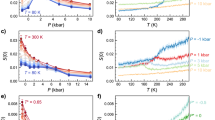Abstract
The formation of glasses is normal for substances that remain liquid over a wide temperature range (the ‘good glassformers’) and can be induced for most liquids if cooling is fast enough to bypass crystallization. During reheating but still below the melting point, good glassformers exhibit glass transitions as they abruptly transform into supercooled liquids, whereas other substances transform directly from the glassy to the crystalline state. Whether water exhibits a glass transition before crystallization has been much debated over five decades1,2,3,4,5,6. For the last 20 years, the existence of a glass transition at 136 K (ref. 3) has been widely accepted2,3,4, but the transition exhibits qualities difficult to reconcile with our current knowledge of glass transitions2,5,6. Here we report detailed calorimetric characterizations of hyperquenched inorganic glasses that, when heated, do not crystallize before reaching their glass transition temperatures. We compare our results to the behaviour of glassy water and find that small endothermic effects, such as the one attributed to the glass transition of water, are only a ‘shadow’ of the real glass transition occurring at higher temperatures, thus substantiating the conclusion6 that the glass transition of water cannot be probed directly.
This is a preview of subscription content, access via your institution
Access options
Subscribe to this journal
Receive 51 print issues and online access
$199.00 per year
only $3.90 per issue
Buy this article
- Purchase on Springer Link
- Instant access to full article PDF
Prices may be subject to local taxes which are calculated during checkout



Similar content being viewed by others
References
Pryde, J. A. & Jones, G. O. Properties of vitreous water. Nature 170, 635–639 (1952)
Angell, C. A. Liquid fragility and the glass transition in water and aqueous solutions. Chem. Rev. 102, 2627–2649 (2002)
Johari, G. P., Hallbrucker, A. & Mayer, E. The glass transition of hyperquenched glassy water. Nature 330, 552–553 (1987)
Johari, G. P. Does water need a new Tg? J. Chem. Phys. 116, 8067–8073 (2002)
MacFarlane, D. R. & Angell, C. A. Nonexistent glass transition for amorphous solid water. J. Phys. Chem. 88, 759–762 (1984)
Velikov, V., Borick, S. & Angell, C. A. The glass transition of water, based on hyperquenching experiments. Science 294, 2335–2338 (2001)
Jenniskens, P., Banham, S. F., Blake, D. F. & McCoustra, M. R. S. Liquid water in the domain of cubic crystalline ice I-c. J. Chem. Phys. 107, 1232–1241 (1997)
Johari, G. P. Liquid state of low-density pressure-amorphized ice above its Tg. J. Phys. Chem. B 102, 4711–4714 (1998)
Smith, R. S. & Kay, B. D. The existence of supercooled liquid water at 150 K. Nature 398, 788–791 (1999)
Ito, K., Moynihan, C. T. & Angell, C. A. Thermodynamic determination of fragility in liquids and a fragile-to-strong liquid transition in water. Nature 398, 492–495 (1999)
Kivelson, D. & Tarjus, G. H2O below 277 K: A novel picture. J. Phys. Chem. B 105, 6620–6627 (2001)
Hallbrucker, A. & Mayer, E. Calorimetric study of the vitrified liquid water to cubic ice phase transition. J. Phys. Chem. 91, 503–505 (1987)
Kohl, I., Mayer, E. & Hallbrucker, A. The glassy water-cubic ice system: a comparative study by X-ray diffraction and differential scanning calorimetry. Phys. Chem. Chem. Phys. 2, 1579–1586 (2000)
Hallbrucker, A., Mayer, E. & Johari, G. P. Glass-liquid transition and the enthalpy of devitrification of annealed vapor-deposited amorphous solid water. A comparison with hyperquenched glassy water. J. Phys. Chem. 93, 4986–4990 (1989)
Angell, C. A. & Tucker, J. C. Heat capacity changes in glass-forming aqueous solutions, and the glass transition in vitreous water. J. Phys. Chem. 84, 268–272 (1980)
Ghormley, J. A. Enthalpy changes and heat-capacity changes in transformations from high-surface-area amorphous ice to stable hexagonal ice. J. Chem. Phys. 48, 503–511 (1968)
Hodge, I. M. Enthalpy recovery in amorphous materials. J. Non-Cryst. Solids 169, 211–266 (1994)
Johari, G. P. Water's endotherm, the sub-Tg peak of glasses and Tg of water. J. Chem. Phys. 119, 2935–2937 (2003)
Huang, J. & Gupta, P. Enthalpy relaxation in thin glass fibers. J. Non-Cryst. Solids 151, 175–181 (1992)
Yue, Y.-Z., Jensen, S. L. & Christiansen, J. de C. Physical aging in a hyperquenched glass. Appl. Phys. Lett. 81, 2983–2985 (2002)
Angell, C. A. et al. Potential energy, relaxation, vibrational dynamics and the boson peak, of hyperquenched glasses. J. Phys. Condensed Matter 15, S1051–S1068 (2003)
Inoue, A., Masumoto, T. & Chen, H. S. Enthalpy relaxation behaviour of metal-metal (Zr-Cu) amorphous alloys upon annealing. J. Mater. Sci. 20, 4057–4068 (1985)
Angell, C. A. in Water Science for Food, Health, Agriculture and Environment (eds Berk, Z., Leslie, R. B., Lilford, P. J. & Mizrahi, S.) 1–30 (Technomic, Lancaster, 2001)
Ngai, K. L., Magill, J. H. & Plazek, D. J. Flow, diffusion and crystallization of supercooled liquids: Revisited. J. Chem. Phys. 112, 1887–1892 (2000)
Hofer, K., Hallbrucker, A., Mayer, E. & Johari, G. P. Vitrified dilute aqueous-solutions. 3. Plasticization of waters H-bonded network and the glass-transition temperatures minimum. J. Phys. Chem. 93, 4674–4677 (1989)
Johari, G. P., Hallbrucker, A. & Mayer, E. Two calorimetrically distinct states of liquid water below 150 kelvin. Science 273, 90–92 (1996)
Johari, G. P., Hallbrucker, A. & Mayer, E. The dielectric behavior of vapor-deposited amorphous solid water and of its crystalline forms. J. Chem. Phys. 95, 6849–6855 (1991)
Angell, C. A. Amorphous water. Annu. Rev. Phys. Chem. 55, 559–583 (2004)
Handa, Y. P. & Klug, D. D. Heat capacity and glass transition of amorphous ice. J. Chem. Phys. 92, 3323–3325 (1988)
Fleissner, G., Hallbrucker, A. & Mayer, E. Increasing contact-ion pairing as a supercooled water anomaly. Estimation of the fictive temperature of hyperquenched glassy water. J. Phys. Chem. B 102, 6239–6247 (1998)
Axten, C. W. et al. Man-made Vitreous Fibers: Nomenclature, Chemical and Physical Properties (ed. Easters, W.) 17 (TIMA, Inc., Stamford, CT, 1991–1993)
Yue, Y.-Z., Christiansen, J. de C. & Jensen, S. L. Determination of the fictive temperature for a hyperquenched glass. Chem. Phys. Lett. 357, 20–24 (2002)
Acknowledgements
We are grateful for the support of Rockwool International, Denmark, Department of Production, Aalborg University, Denmark (to Y.-Z.Y.) and for a Solid State Chemistry grant from the National Science Foundation (C.A.A.). We thank S.L. Jensen for help with samples.
Author information
Authors and Affiliations
Corresponding author
Ethics declarations
Competing interests
The authors declare that they have no competing financial interests.
Rights and permissions
About this article
Cite this article
Yue, Y., Angell, C. Clarifying the glass-transition behaviour of water by comparison with hyperquenched inorganic glasses. Nature 427, 717–720 (2004). https://doi.org/10.1038/nature02295
Received:
Accepted:
Issue Date:
DOI: https://doi.org/10.1038/nature02295
This article is cited by
-
Densified network glasses and liquids with thermodynamically reversible and structurally adaptive behaviour
Nature Communications (2015)
-
Atomic and vibrational origins of mechanical toughness in bioactive cement during setting
Nature Communications (2015)
-
Evolution of hidden localized flow during glass-to-liquid transition in metallic glass
Nature Communications (2014)
-
Irreversibility of Pressure Induced Boron Speciation Change in Glass
Scientific Reports (2014)
-
Thermomechanical Morphology of Peas and Its Relation to Fracture Behaviour
Food and Bioprocess Technology (2013)
Comments
By submitting a comment you agree to abide by our Terms and Community Guidelines. If you find something abusive or that does not comply with our terms or guidelines please flag it as inappropriate.



